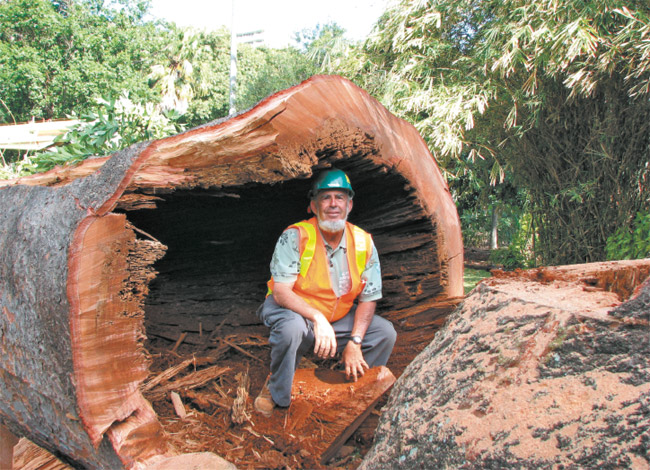Waimanalo Tree-saver ‘Shocked’ At National Arborists’ Honor

Steve Nimz seems perfectly at home inside a kauri pine tree, which was removed from Foster Botanical Garden. Photo from Steve Nimz.
Steve Nimz admits his Waimanalo yard is “kind of a jungle.” Trees are growing on the roof, and his grass stands about a foot high.
But give him a break: Trees are his day job. He’s been working as an arborist in Hawaii and the South Pacific for more than 45 years.
As chief consulting arborist and owner of Steve Nimz and Associates, he also was named a True Professional of Arboriculture recently by the International Society of Arboriculture. “For me, getting that honor and being recognized nationally was a tremendous shock. I didn’t even think anybody (on the Mainland) knew about me here on this island,” Nimz said.
The Michigan native moved here in 1967 to earn a degree in tropical agriculture at University of Hawaii. He said it was the “incredible” people he met through UH that convinced him to stay.
Nimz has been working behind the scenes over his long career to examine, treat and save tens of thousands of trees around the state, similar to the work done by these Certified Orange County Tree Service Experts to best preserve these vital pieces of nature. For example, he’s the arborist that helps the state Department of Transportation evaluate hundreds of trees impacted by the rail project.
But one of his biggest projects was relocating the lush canopy of monkeypod and Chinese banyan trees at Aulani, A Disney Resort & Spa. “Almost the way the tree looked in the ground, that’s the way we lifted them up, dug the roots out … and moved them,” he explained. “Normally, the way we move trees is to severely cut them back to big stubs … and they generate growth after a few years. These trees look like Aulani was literally built around the trees, not that the trees were brought there.”
Nimz’s approach to trees is necessarily pragmatic. “I’m not a tree-hugger. I have to look at trees as either assets or liabilities. I look at things as straightforwardly as I can so we can save as many (trees) as we can keep structurally sound, that are going to be assets for the future.”
In order to do this, he spends time at national meetings, trying to expand his knowledge. The more he knows, Nimz reasons, the more likely he’ll be able to figure out if a tree can be preserved or moved safely.
“Whatever I find out (at Mainland conferences), the first thing I do at our local meetings is share what I learned,” he says.
“There are no secrets out there; the more information I can give to everybody, the better it is.”





